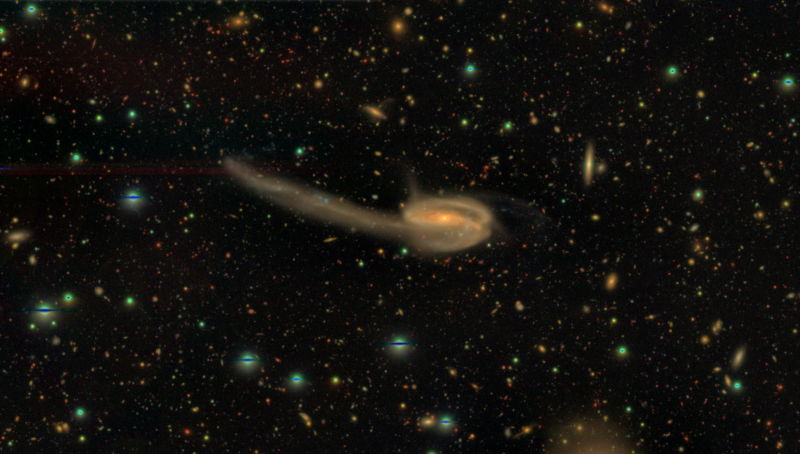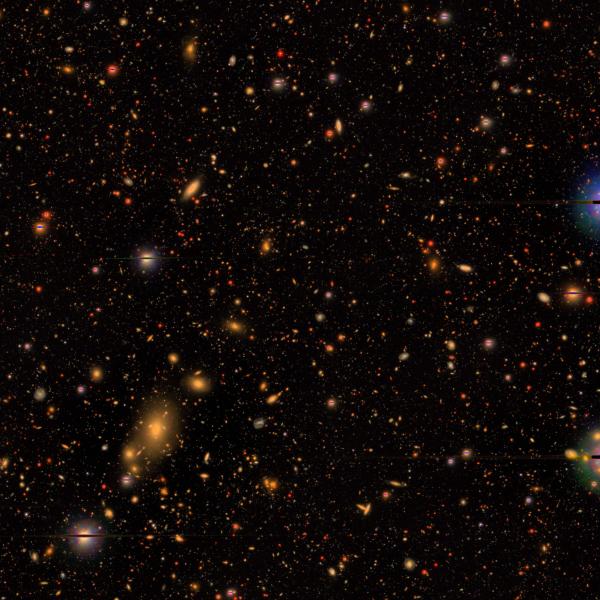March 2, 2017
Kavli Institute for the Physics and Mathematics of the Universe (Kavli IPMU)
The first massive data set of a “cosmic census” has been released using the largest digital camera on the Subaru Telescope. With its beautiful images now available for the public at large, figuring out the fate of the Universe has come one step closer.
Data from the Hyper Suprime-Cam Subaru Strategic Program (HSC-SSP) was released to the public on February 27th, 2017. HSC-SSP is a large survey being done using HSC, an optical imaging camera mounted at the prime focus of the Subaru Telescope. Since it is difficult to analyze such a huge dataset with standard tools, the National Astronomical Observatory of Japan (NAOJ) has developed a dedicated database and interface for ease of access and use of the data.
NAOJ embarked on the HSC-SSP survey in collaboration with the Kavli Institute for the Physics and Mathematics of the Universe (Kavli IPMU) in Japan, the Academia Sinica Institute of Astronomy and Astrophysics (ASIAA) in Taiwan, and Princeton University in the United States. The project will survey 300 nights over 5 to 6 years. This survey consists of three layers: Wide, Deep, and UltraDeep, using optical and near infrared wavelengths in five broad bands (g, r, i, z, y) and four narrow-band filters.
This first public dataset already contains almost 100 million galaxies and stars. It demonstrates that HSC-SSP is making the most from the performance of the Subaru Telescope and HSC. In contrast, the US-based Sloan Digital Sky Survey (SDSS)—which is known for its wide area observation and equivalent data sets—took over 10 years to establish. The total amount of data taken so far by the HSC-SSP, meanwhile, comprises 80 terabytes, which is comparable to the size of about 10 million images by a general digital camera.
This release includes data from the first 1.7 years (61.5 nights of observations beginning in 2014). The observed areas covered by the Wide, Deep, and UltraDeep layers are 108, 26, and 4 square degrees, respectively. The limiting magnitudes, which refer to the depth* of the observations, are 26.4, 26.6 and 27.3 mag in r-band (about 620 nm wavelength), respectively, allowing observations of some of the most distant galaxies in the Universe.
In multi-band images, the images are extremely sharp, with only 0.6 to 0.8 arcseconds across for point-like objects like stars. One arcsecond equals 3600th part of a degree. The high-quality data will allow an unprecedented view into the nature and evolution of galaxies and dark matter.
“Since 2014, we have been observing the sky with HSC, which can capture a wide-field image with high resolution,” said NAOJ Professor Satoshi Miyazaki, the leader of the HSC-SSP. “We believe the data release will lead to many exciting astronomical results, including exploring the nature of dark matter and dark energy, as well as asteroids in our own solar system objects, and galaxies in the Early Universe. SSP team members are now preparing a number of scientific papers based on the data. We plan to publish them in a special issue of the Publications of Astronomical Society of Japan. Moreover, we hope that interested members of the public will access the data and enjoy the real Universe imaged by the Subaru telescope, one of the largest of its kind in the world.”
Kavli IPMU Director Hitoshi Murayama added: “When we consider the future of Japan, we must use data from the census to see how quickly the population is aging. Similarly, when we consider the evolution and destiny of the Universe, it pays to take a “census” of it. Which is to say, it is necessary to observe a large number of celestial bodies over a wide distance and range and to analyze enormous amounts of data. It is for this purpose that the HSC digital camera—which has one of the world’s largest telescope with a wide field of vision—was created.
“Kavli IPMU contributed to the design of its optical systems, including its huge and special lens of about 1m in size, the production of casings that do not deform under the harsh climatic conditions of a mountain summit, and a machine control system that controls its 3m camera at the micron level. In this way, the census can take images that would take thousands of years with the Hubble Space Telescope, but in a few years. As a result, the HSC has come closer still to unraveling the fate of the Universe. So I am very excited about the future use of this data.
“Furthermore, after 2020, we plan to investigate in more detail celestial objects photographed by the HSC, using the Prime Focus Spectrograph (PFS) currently under construction, which is part of the Subaru Measurement of Images and Redshifts (SuMIRe) project. We look forward to its future development and the data emanating from SuMIRe.”
 Kavli IPMU Professor Masahiro Takada, who serves as a co-chair of the HSC-SSP Science Working Group, said: “Data sets of images of the Universe captured by the HSC/Subaru telescope is now available for the public. The Subaru telescope allows us to examine very faint objects in the Universe over a wide area of the sky. As for our Milky Way Galaxy, we can look over distant, faint stars reaching up to the edge of the Galaxy, and thereby investigate the processes of its formation. We were able to catalog almost 100 million galaxies that exist across the distant Universe, which have been—with time—changing from the decelerating expansion phase to the accelerating phase (this happened about 7 billion years ago). That data allows for a detailed study of the history of the Universe with the aim of shedding light on such topics as the origin of galaxies as well as the nature of dark matter and dark energy.”
Kavli IPMU Professor Masahiro Takada, who serves as a co-chair of the HSC-SSP Science Working Group, said: “Data sets of images of the Universe captured by the HSC/Subaru telescope is now available for the public. The Subaru telescope allows us to examine very faint objects in the Universe over a wide area of the sky. As for our Milky Way Galaxy, we can look over distant, faint stars reaching up to the edge of the Galaxy, and thereby investigate the processes of its formation. We were able to catalog almost 100 million galaxies that exist across the distant Universe, which have been—with time—changing from the decelerating expansion phase to the accelerating phase (this happened about 7 billion years ago). That data allows for a detailed study of the history of the Universe with the aim of shedding light on such topics as the origin of galaxies as well as the nature of dark matter and dark energy.”
Notes:
*“Depth” of an observation refers to how dim objects can be studied. The power of large aperture mirrors (8.2 m for the Subaru Telescope) to collect light is the crucial factor, as well as the exposure time. For astronomical objects of the same intrinsic brightness, depth is literally how far one can look; larger numbers of “magnitude” correspond to deeper observations.
Relevant links:
Please also look at the press release from the National Astronomical Observatory concerning this matter.
HSC-SSP Public data release site
HSC project Website
HSC-SSP Website
Research contact:
Professor Masahiro Takada
The University of Tokyo International Institute for Advanced Studies
Kavli Institute for the Physics and Mathematics of the Universe
E-mail: masahiro.takada _ at _ ipmu.jp
Tel: 04 - 7136 - 6510
Please change * _ at _ to @
Media contact:
John Amari
Public Relations Office
The University of Tokyo International Institute for Advanced Studies
Kavli Institute for the Physics and Mathematics of the Universe
E-mail: press_at_ipmu.jp
Tel: 04-7136-5977
Please change * _ at _ to @








